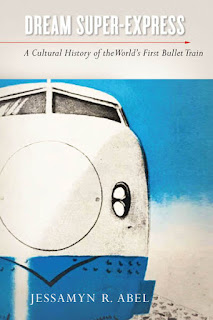
Abel applied the “Page 99 Test” to her new book, Dream Super-Express: A Cultural History of the World's First Bullet Train, and reported the following:
A potential reader opening to page 99 of Dream Super-Express would get very little sense of the book’s argument and might not even understand that it was about the debut of the world’s first bullet train in 1964. But they would see an example of its methodology.Learn more about Dream Super-Express at the Stanford University Press website.
That page is almost entirely taken up by a 1965 Japanese monster movie poster, followed by a description of relevant aspects of its plot. It is undoubtedly one of the book’s more visually interesting pages, dominated by a picture of the monster Gamera astride an elevated track, grasping an unfortunate bullet train, with the ruins of its destructive rampage through Tokyo behind it: crumbling structures symbolizing postwar Japanese democracy, industry, and technological prowess. However, aside from the image of the titular “dream super-express” in the monster’s claws, it fails to convey a clear idea of what the book is about. The passage in question is a somewhat tongue-in-cheek discussion of the monster movie in a chapter on the bullet train’s transformation of the space of the Tōkaidō region linking Japan’s major cities of Tokyo, Nagoya, Kyoto, and Osaka.
A reader inspired to continue for two more pages would find an interpretation of the fictional creature’s ultimate fate as an echo of what that chapter’s analysis of the bullet train reveals about the social construction of space: though ruling forces may seek to shape space through development of new infrastructures and technologies, they can never control it completely, as other actors (including the train itself) constantly reinvent that space according to competing ideas, interests, and exigencies. This is fairly representative of the book as a whole, which shows how the bullet train, built over the course of the early 1960s, interacted with major historical trends of its times, including the development of popular protest movements, the emergence of the “information society” concept, the reconstruction of public memory of war and empire, and the use of technology in public diplomacy.
Therefore, the test works in that page 99 evokes the method of reading all sorts of materials—popular films, of course, but also government reports, news articles, essays, advertisements, novels, television shows, and more—to find out what people thought about the bullet train. Why, in the age of jet travel and the beginnings of space exploration, were people so excited about a train? Gamera doesn’t answer the question, but he shows us how.
--Marshal Zeringue



